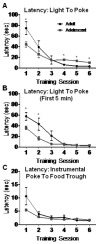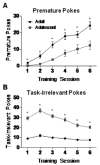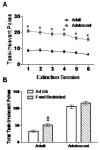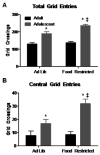Adolescents exhibit behavioral differences from adults during instrumental learning and extinction
- PMID: 20141277
- PMCID: PMC2871391
- DOI: 10.1037/a0018463
Adolescents exhibit behavioral differences from adults during instrumental learning and extinction
Abstract
Adolescence is associated with the development of brain regions linked to cognition and emotion. Such changes are thought to contribute to the behavioral and neuropsychiatric vulnerabilities of this period. We compared adolescent (Postnatal Days 28-42) and adult (Postnatal Day 60+) rats as they performed a simple instrumental task and extinction. Rats were trained to poke into a hole for a food-pellet reinforcer. After six days of training, rats underwent extinction sessions in which the previously rewarded behavior was no longer reinforced. During extinction, we examined the effects of continued presentation of a cue light and food restriction. Adults and adolescents exhibited similar performance during training, although adolescents made more task-irrelevant pokes, consistent with increased exploration. Adults made more premature pokes, which could indicate a more exclusive focus on the task. During extinction, adolescents made more perseverative (previously reinforced) pokes than adults. This behavior was strongly modulated by the combination of motivational factors present (food restriction and cue light), indicating that adolescents were differentially sensitive to them. Furthermore, food restriction induced greater open-field activity in adolescents but not in adults. Thus, as the neural circuitry of motivated behavior develops substantially during adolescence, so too does the behavioral sensitivity to motivational factors. Understanding how such factors differently affect adolescents may shed light on mechanisms that lead to the development of disorders that are manifested during this period.
(c) 2009 APA, all rights reserved.
Figures







References
-
- Adriani W, Chiarotti F, Laviola G. Elevated novelty seeking and peculiar d-amphetamine sensitization in periadolescent mice compared with adult mice. Behav Neurosci. 1998;112(5):1152–1166. - PubMed
-
- Adriani W, Laviola G. Elevated levels of impulsivity and reduced place conditioning with d-amphetamine: two behavioral features of adolescence in mice. Behav Neurosci. 2003;117(4):695–703. - PubMed
-
- Adriani W, Laviola G. Windows of vulnerability to psychopathology and therapeutic strategy in the adolescent rodent model. Behav Pharmacol. 2004;15(5-6):341–352. - PubMed
-
- Andersen SL, Thompson AT, Rutstein M, Hostetter JC, Teicher MH. Dopamine receptor pruning in prefrontal cortex during the periadolescent period in rats. Synapse. 2000;37(2):167–169. - PubMed
-
- Andrucci GL, Archer RP, Pancoast DL, Gordon RA. The relationship of MMPI and Sensation Seeking Scales to adolescent drug use. J Pers Assess. 1989;53(2):253–266. - PubMed

